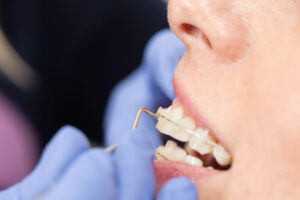What Do Rubber Bands Do for Braces: A Guide on Orthodontic Elastics

Key Takeaways
- Orthodontic Elastics’ Role: Rubber bands are essential for correcting misalignments between the upper and lower jaws, effectively addressing conditions like overbites and underbites. They exert necessary forces to align the jaw correctly.
- Strategic Placement for Effective Treatment: Orthodontists strategically place these elastics to connect different points from the upper to the lower braces, guiding the teeth and jaw into the desired position. This active participation is crucial in your orthodontic journey.
- Comprehensive Correction Capabilities: Rubber bands provide additional force needed to move teeth in directions that braces alone cannot achieve, which is vital for achieving optimal alignment and bite.
- Functional and Aesthetic Improvements: The use of rubber bands enhances chewing and speaking abilities by aligning the jaw and teeth properly. They also contribute to the aesthetic goals of orthodontic treatment, ensuring a harmonious and balanced smile.
- Customizable Treatment Options: Elastic bands come in various sizes and strengths, allowing orthodontists to customize the force applied for individual patient needs, ensuring effective and comfortable treatment.
- Types of Rubber Bands: There are several types of rubber bands, including Interarch Bands (for bite correction), Intra-arch Bands (for aligning teeth within the same arch), and specialized configurations like Triangle Elastics for complex movements.
- Maintenance and Care: Consistent wear, regular replacement, proper placement, maintaining good oral hygiene, carrying extras, monitoring for allergies, and regular orthodontic check-ups are essential for maximizing the effectiveness of rubber bands in orthodontic treatment.
Table of Contents
Orthodontic elastics are more than just simple rubber bands; they are integral to correcting misalignments between the upper and lower jaws, known as malocclusions. Whether you’re addressing an overbite, where the upper teeth protrude beyond the lower teeth, or an underbite, where the lower jaw is forward compared to the upper jaw, rubber bands exert the necessary force to align your jaw correctly.
Orthodontists strategically place these elastics to connect various points from the upper to the lower braces, creating a force that guides the teeth and jaw into the desired position. By wearing your orthodontic elastics as instructed, you’re actively participating in your orthodontic journey.
Why Should You Use Rubber Bands With Braces?
Using rubber bands with dental braces is important for your orthodontic treatment for several reasons:
- Correct Jaw Alignment: Rubber bands help adjust the positioning of the jaw by applying force in specific directions. This is essential for treating misalignments such as overbites or underbites, where the upper and lower jaws do not align properly.
- Fine-Tune Tooth Movement: While braces control the position of the teeth along the archwire, rubber bands provide additional force needed to move the teeth in a direction that braces alone cannot achieve. This helps in achieving optimal alignment and bite.
- Speed Up Treatment: By efficiently moving teeth into their correct positions, rubber bands can potentially shorten the overall time needed for braces. They ensure that both the teeth and jaw work together towards the final goal of a well-aligned bite.
- Enhance Functional Benefits: Properly aligned teeth and jaws improve chewing and speaking abilities. Rubber bands work towards correcting any functional issues associated with misaligned teeth and jaws, contributing to better overall oral health.
- Achieve Desired Aesthetic Results: Ultimately, rubber bands contribute to the aesthetic goals of orthodontic treatment. They help ensure that your teeth are not only straight but also that your overall smile is harmonious and balanced.
How Orthodontic Elastic Bands Work
Orthodontic elastic bands, or rubber bands, play a pivotal role in the mechanics of braces, providing targeted forces used to correct misalignments of the teeth and jaws.
Here’s how these small but powerful tools work:
Application of Force
Orthodontic elastics stretch between various hooks on the upper and lower braces. Depending on how they are applied, they can exert different forces in various directions. This allows orthodontists to use them for specific movements that the braces alone might not accomplish.
Directional Flexibility
The elastics can be connected in multiple configurations—vertically, horizontally, or diagonally—depending on the correction needed. For example, a vertical setup might help close gaps between the teeth, while a diagonal configuration could correct an overbite by pulling the jaw forward or backward.
Adjustable Tension
Elastic bands come in different sizes and strengths, allowing orthodontists to control the amount of pressure applied to the teeth and jaws. This customization is crucial as it ensures that each patient receives just the right force needed for their specific orthodontic issues.
Continuous Correction
Unlike the fixed brackets and wires of braces, which are adjusted during orthodontic visits, elastic bands work continuously. If you wear your elastics, they encourage the teeth and jaw to move gradually over time.
Patients are typically instructed to change their elastics daily to maintain optimal elasticity and effective force.
Collaborative Movement
While braces adjust the position of individual teeth along the archwire, the rubber bands work by pulling groups of teeth and segments of the jaw into alignment with each other.
This collaborative approach helps in achieving a balanced bite and proper jaw alignment.
Benefits of Using Rubber Bands with Braces
Enhanced Alignment and Bite Correction
Elastic rubber bands apply additional force necessary to correct more complex alignment issues that braces alone can’t fully address. They are particularly effective in correcting bite discrepancies such as overbites, underbites, and crossbites by aligning the jaw properly relative to the upper and lower teeth.
Faster Treatment Progress
By effectively aiding the movement of teeth and the jaw, rubber bands can accelerate the orthodontic process. They provide continuous, directed forces that work alongside the braces to move teeth into the desired position more efficiently.
Improved Dental Functions
Properly aligned teeth and jaws enhance chewing and speaking abilities. Rubber bands help to adjust the positioning of jaws and teeth, which reduces the strain on jaw muscles and joints, leading to better overall oral function.
Aesthetic Enhancements
Beyond the functional improvements, the use of rubber bands contributes to a more symmetrical and visually appealing alignment of the teeth. This results in a more attractive smile, which is often the most noticeable benefit of orthodontic treatment.
Prevention of Future Dental Issues
By ensuring proper alignment and bite, rubber bands help in preventing other potential future dental problems, such as uneven wear of the teeth, TMJ (temporomandibular joint) disorders, and difficulties in maintaining oral hygiene.
Customizable Treatment
Orthodontic rubber bands come in various sizes and strengths, allowing orthodontists to tailor the force applied according to individual patient needs. This customization ensures that each patient receives the most effective and comfortable treatment possible.
What Bite Issues Do Rubber Bands Fix?
Rubber bands are an essential tool in orthodontics for fixing various bite issues. By applying precise forces to the teeth and jaw, these small but powerful elastics help correct misalignments that braces alone might not fully address.
Here are some of the specific bite issues that rubber bands can help fix:
- Overbite: An overbite occurs when the upper teeth protrude significantly over the lower teeth. Rubber bands can apply backward pressure on the upper teeth and forward pressure on the lower teeth, encouraging the teeth to align more appropriately and reducing the overbite.
- Underbite: This is the opposite of an overbite, where the lower teeth extend past the upper teeth. Rubber bands are used to pull the lower jaw back and the upper jaw forward, helping to correct the alignment and improve the bite.
- Crossbite: In a crossbite, some upper teeth may bite inside the lower teeth rather than outside. Rubber bands can be strategically placed to move the affected teeth into the correct position, ensuring that the upper and lower teeth align properly on each side of the mouth.
- Open Bite: An open bite is where there is an obvious gap between the upper and lower teeth when the mouth is closed. Rubber bands can help lower the upper teeth and/or raise the lower teeth to close this space.
- Excessive Spacing or Crowding: While not directly a ‘bite’ issue, rubber bands can also help in adjusting the spacing and alignment of teeth, which in turn can influence how the bite fits together. They can assist in closing gaps or redistributing teeth where there is crowding.
What Are the Main Types of Rubber Bands in Orthodontics?
In orthodontics, rubber bands, also known as elastics, come in various types, each designed for specific purposes in the alignment and adjustment of teeth and jaws.
Here are the main types of rubber bands used in orthodontic treatment:
- Interarch Bands: These are the most common type of orthodontic elastics. They connect the upper and lower teeth, and are essential for correcting bite issues. Interarch bands come in different configurations such as Class I, Class II, and Class III, which are selected based on the particular jaw alignment needs:
- Class I Elastics help align the bite and close gaps.
- Class II Elastics are used to correct overbites by pulling the upper teeth back and the lower teeth forward.
- Class III Elastics address underbites by pulling the lower teeth back relative to the upper teeth.
- Intra-arch Bands: These elastics are used within the same arch, either upper or lower, to correct alignment and spacing issues. They help with straightening and evenly spacing the teeth by pulling them closer or maintaining a proper distance between them.
- Vertical Bands: Vertical elastics run up and down from top to bottom teeth to help close open bites or adjust the vertical positioning of the teeth.
- Cross Elastics: These are used to fix crossbites by pulling teeth on one side of the mouth toward the cheek or tongue, depending on the direction needed to correct the bite.
- Triangle Elastics: Often used in complex cases, these involve multiple teeth in a triangular configuration to achieve specific movements and torque adjustments.
Maintenance and Care When Using Rubber Bands
You need to take care of your rubber bands during orthodontic treatment to make sure they effectively aid in moving your teeth and aligning your jaw.
Here are essential tips on how to maintain and care for your orthodontic elastics:
Wear As Long as Instructed
Follow your orthodontist’s instructions on how often and how long to wear your rubber bands. Consistency is key to achieving the desired results. Typically, you’ll need to wear them almost all the time, removing them only for eating, brushing, and replacing them with new ones.
Replace Your Elastics Regularly
Rubber bands lose their elasticity over time, which can decrease their effectiveness. Replace them at least once a day or as advised by your orthodontist, generally every time you brush your teeth or after meals if they get dirty or stretched out.
Place Properly
Make sure you understand exactly where and how to attach the rubber bands. Incorrect placement can lead to improper force application, which can delay your treatment or alter its course. Your orthodontist should provide you with a diagram or demonstrate the placement during your appointment.
Keep a Good Oral Hygiene
Keep your teeth and braces clean. Braces can trap food and plaque, and wearing rubber bands can make it more challenging to keep areas around the brackets and between the teeth clean. Brush at least twice a day and floss daily using tools like floss threaders or water flossers designed for braces.
Carry Extras
Always have a spare pack of elastics on hand, whether at school, work, or home. This way, you can replace them immediately if they break or when you need to take them out for meals.
Monitor for Allergic Reactions
Although rare, some people are allergic to the latex in rubber bands. If you notice signs of irritation or allergic reactions, such as itching, redness, or swelling around your mouth, contact your orthodontist immediately. Non-latex elastics are available for those with allergies.
Regular Orthodontic Check-ups
Attend all scheduled orthodontic appointments. These visits allow your orthodontist to monitor your progress and make adjustments to your treatment plan if necessary. They can also address any issues you might have with the rubber bands or braces.
FAQ on What Do Rubber Bands Do For Braces
When do you start wearing rubber bands for braces?
You typically start wearing rubber bands for braces several months into treatment, once your teeth have adjusted to the braces.
Your orthodontist will decide the right time to introduce rubber bands based on how your teeth and jaw are aligning.
The specific timing varies, as each patient’s orthodontic needs are unique. Regular check-ups allow your orthodontist to monitor your progress and begin using rubber bands at the optimal stage to enhance your treatment.
How long do orthodontic rubber bands stay on your braces?
Orthodontic rubber bands typically stay on your braces throughout most of your treatment, though the exact duration can vary depending on your specific orthodontic needs.
Your orthodontist will guide you on how long to wear them each day, usually recommending continuous wear except when eating or brushing.
The overall period for using rubber bands aligns with the phases of your treatment that require the correction of jaw alignment and bite adjustments.
Are there any side effects?
Yes, wearing orthodontic rubber bands can have some side effects, mainly if not used as directed. You might experience discomfort or soreness initially as your teeth and jaws adjust to the pressure. Improper use can lead to misaligned teeth or prolonged treatment.
There’s also a risk of allergic reactions to the latex in some bands, though non-latex alternatives are available. Regular consultations with your orthodontist will help manage any side effects effectively.
What to do if the elastics come off
If your orthodontic elastics come off, you should replace them as soon as possible using the instructions provided by your orthodontist. Always keep spare elastics on hand for such situations.
If you’re unsure about how to reattach them correctly, refer to the placement guide your orthodontist gave you or contact their office for guidance. Prompt replacement is crucial to maintain the consistent pressure needed for effective treatment and to stay on track with your orthodontic goals.
Fact Checked
Our dedicated team rigorously evaluates every article and guide to ensure the information is factual, up-to-date, and free of bias.
Updated Regularly
We update our articles and reviews regularly to ensure you have access to the latest data in the dental industry.
The content on Dental3DU’s blog is intended for educational purposes only. This information should not be relied upon as professional medical counsel. Be sure to always consult with your dentist about the dangers and benefits of any medication, treatment or procedure.







